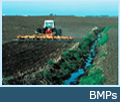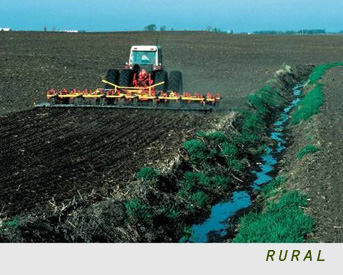        |
|
"In the end, our society will be defined not only by what we created but by what we refuse to destroy." - John Sawhill ....................................... |
The Economics of Clean Water - Urban - In Somerset, Maryland, where rain gardens were introduced in 1990, each residential property features a 300-to-400-square foot rain garden. Besides the ecological benfits and opportunity to showcase native plants, the Somerset Project saved the city nearly $300,000 on curbs, sidewalks, and gutters, traditional infrastructure features that were unnecessary with the addition of rain gardens. (Source: Black & Veatch Engineering, http://www.bvraingares.com/) ...................................................................
Rain Gardens - Rain gardens are shallow depressions in your yard designed to naturally collect water that runs off your roof or is discharged from your sump pump. They are usually planted with native perennial wildflowers and grasses that are tolerant of wet conditions. Rain gardens are beautiful and low-maintenance, they provide habitat for wildlife such as birds and butterflies, and they help protect and conserve water. To read more about rain garden plants, design, and maintenance check these links: ................................................................... Build your Own Rain Garden - from Applied Ecological Services Rain Gardens: A How-to-Manual for Homeowners - from University of Wisconsin Extension Services Design & Plant: A Step by Step Worksheet for Rain Gardens Plant Guides & Additional Resources Perennials, Trees & Shrubs for Rain Gardens Plant Selector: Interactive, Online Plant Guide - from BlueThumb.org Online Publications & Articles Rain Gardens: Healthy for Nature and People - Chicago Wilderness Magazine, Spring 2001 Rain Gardens: Using Spectacular Wetland Plantings to Reduce Runoff - Plants & Garden News, Brooklyn Botanic Garden; Vol.19, No1, Spring 2004 ................................................................... New Rain Barrel Order! Due to the overwhelming sucess of our rain barrel cost-share program, we will be ordering additional barrels. Rain barrels are a great way to save money & help improve water quality. Reserve yours today! Download order form here. Call or email Sarah for more information. To learn more about rain barrels, check out these links: Rain Barrels : A Home Owner's Guide - from Southwest Florida Water Management District Healthy Landscapes: Rain Barrels - from University of Rhode Island Using Rain Barrels for Water Collection - from Rain Barrel Guide.com |
||
|
  |


